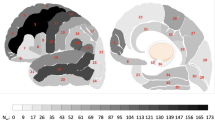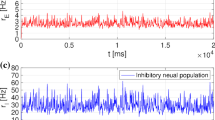Abstract
In our previous paper we have given a neuroglia modulated neuronal network model which may display chaotic behaviours under certain parametric values. This work is an attempt to correlate the functions of conscious human brains with the chaotic states shown by the EEG patterns under different physiological conditions. Some of the difficulties and precautions of this kind of work are discussed.
Similar content being viewed by others
Literature
Albano, A. M.et al. 1986. “Laser and Brain: Complex Systems with Low Dimensional Attractors.” InDimensions and Entropies in Chaotic Systems—Quantification of Complex Behaviours. G. Mayer-Kress (Ed.), 231–240. Berlin: Springer.
Cohen, A. and I. Procaccia. 1985. “Computing the Kolmogorov Entropy from Time Series Signals of Dissipative and Conservative Dynamic Systems.”Phys. Rev. A. 31A, 1872–1882.
Eckmann, J. P. and D. Ruelle. 1985. “Ergodic Theory of Chaos and Strange Attractors.”Rev. of Mod. Phys. 57, 617–656.
Grassberger, P. 1983. “Generalized Dimensions of Strange Attractors.”Phys. Lett. 97A, 227–230.
— and I. Procaccia. 1983a. “Measuring the Strangeness of Strange Attractors.”Physica 9D, 189–208.
— and —. 1983b. “Characterization of Strange Attractors.”Phys. Rev. Lett.,50, 346–349.
— and —. 1983c. Estimation of Kolmogorov Entropy from A Chaotic Signal.”Phys. Rev. A. 28A, 2591–2593.
Ling, F. H. 1988. A personal communication.
Mayer-Kress, G. and S. P. Layne. 1987. “Dimensionality of Human Electroencephalogoram.” InPerspectives in Biological Dynamics and Theoretical Medicine. S. H. Koslow, A. J. Mandell and M. F. Shlesinger (Eds). Austria: Urban and Schwarzenberg.
Reilly, E. L. 1982. “EEG Recording and Operation of the Apparatus.” InElectroencephalography. E. Niedermeyer and F. L. da Silva (Eds). Austria. Urban and Schwarzenberg.
Takens, F. 1980. “Detecting Strange Attractors in Turbulence.” InDynamical Systems and Turbulence.Lecture Notes in Mathematics, Vol. 898. D. A. Rand and L. S. Young (Eds), pp. 365–381. New York Springer.
Xu Jinghua and Li Wei. 1986. “The Dynamics of Large Scale Neuroglia Network and Its Relations to Brain Functions.”Commun. in Theor. Phys. (Beijing, China)5, 336–346.
— and —. 1987. “The Dynamics of A Glia Modulated Neuroanal Network and Its Relation to Brain Functions.” InLecture Notes in Biomathematics, Vol. 71.Mathematical Topics Population Biology, Morphogenesis and Neurosciences E. Teramoro and Yamaguti (Eds) New York: Springer.
Author information
Authors and Affiliations
Rights and permissions
About this article
Cite this article
Nan, X., Jinghua, X. The fractal dimension of EEG as a physical measure of conscious human brain activities. Bltn Mathcal Biology 50, 559–565 (1988). https://doi.org/10.1007/BF02458853
Received:
Revised:
Issue Date:
DOI: https://doi.org/10.1007/BF02458853




